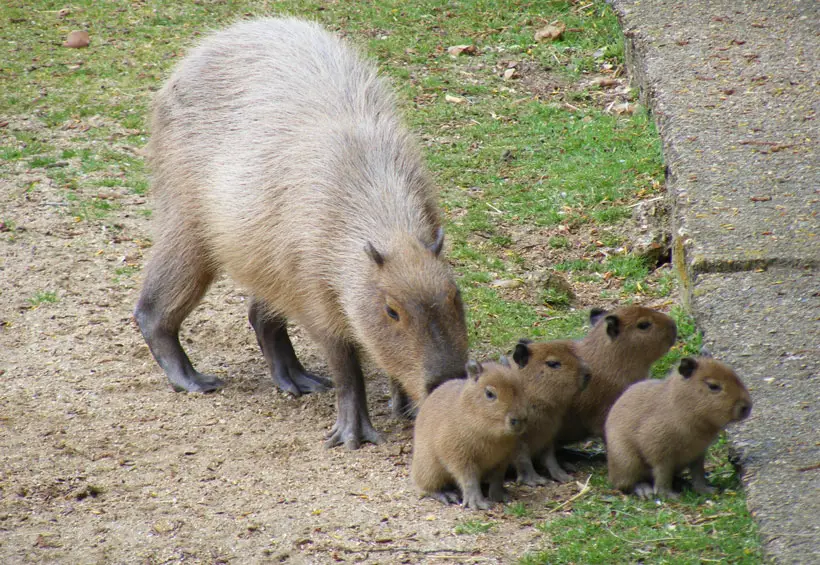Capybara Costs: Understanding The Expenses Of Ownership
Owning a capybara is fun and exciting, but owning and maintaining one is costly. These giant rodents require care, proper housing, and a tight feeding budget. Therefore, it’s important to consider the expenses before owning a Capybara pet.
So, how much does it cost to own a capybara? Owning a Capybara costs between $200 and $400 per month, with an initial cost of between $2,700 and $4,500. These expenses depend on the cost of the animal, its basic needs, additional costs, and the location of its care.
This article reviews the ownership cost of a capybara and the factors resulting in the average cost of keeping a capybara as a pet. In addition, it discusses the additional costs, such as housing and swimming areas, you need to consider before keeping a capybara pet.
How Much Does A Capybara Cost To Buy?
Capybaras are only found in South America, where the climate supports their existence. Their limited availability makes them an expensive species.
Purchasing capybaras from South America will cost between $500 and $1,100. On the other hand, by buying from local pest stores, you can get them at a cheaper cost ranging between $300 and $900.

Factors affecting the cost of Capybara include age, sex, and breed. For example, a male adult ranges between $1,300 and $1,550, while a female breeder costs between $2,400 and $2,600. A young capybara costs between $900 and $1,100, with females being more expensive than males.
You can, however, get a capybara pet from a friend who owns a female breeder. You can also visit farms in Pennsylvania and Texas which are states that legalized buying and selling of this exotic animal.
Capybara Costs: Understanding The Expenses Of Ownership
The expenses of owning a capybara depend on various factors surrounding this giant rodent’s life. Any prospective owner of this pet should prepare for the financial commitments necessary to keep the pet.

Capybaras need a lot of special care and attention to ensure they stay healthy and well. You need to take your pet to a veterinarian after every three months for check-ups.
Here’re the aspects that you must expense on to own and maintain a capybara.
What Are The Costs Of Basic Needs For Capybara Pet
Like any other pet, Capybaras require basic needs for survival and proper growth. Let’s look at the basic needs of Capybara.
Housing
Domesticating a capybara as a pet requires you to provide spacious housing. Capybaras are the largest giant rodents; therefore, they need spacious housing to give room to exercise.
A standard cage measures 72″ long, 24″ high, and 12″ wide and costs between $175 and $200. Ensure it can house all other accessories needed, such as toys, feeding, and water troughs.
Freshwater And Swimming Area
Capybaras love to spend a lot of time in the water to cool down and even spend almost five minutes submerged in water. Provide sufficient water in troughs and have a swimming site outside the cage.
Installing a swimming area is expensive and would cost between $300 and $400 for a standard swimming pool.

Sufficient Food
Capybaras are herbivores and love feeding on grass and other vegetative matter. Its large body mass requires a lot of daily food to remain healthy. Consider putting aside a budget of between $70 and $90 for supplementing their food.
With a four-chambered stomach, they eat forage that humans find hard to digest, such as aquatic vegetation, tree barks, reeds, sugar cane, and plant roots. The feeding cost varies from one diet to another, but capybaras can feed on grass and other readily available vegetables and greens.
Plenty Of Shade
Capybaras cannot withstand direct sun heat during the hot climate and require plenty of shade with sufficient ventilation to cool the animal.
Construct a shade with removable walls using nets and mesh for air circulation. A modern shade with resting areas will cost between $100 and $150, depending on the location and material used.
Medical Expense
Capybaras carry a wide range of diseases and parasites that can be transmitted to human beings during their interaction. Therefore, there is a need to take your capybara to a veterinarian for a medical check-up.
Depending on the location of the health facilities and the disease at hand, it will cost you between $50 and $150 annually. However, with proper care and a feeding schedule, your pet can remain healthy with less medical expenses.
House Training For Capybara And Its Cost
Before handling a capybara, one requires training from a skilled capybara handler. You can get the training in pet training centers around you at an average cost of between $40 and $150.
Afterward, it would be best to spend time house-training your pet to align with your rules. Capybaras are quick to learn and have high intelligence but require patience from the owner.
Avoid using harsh means to instill discipline, as that will upset it to bite you. Instead, use gentle and consistent measures in a friendly manner. All these practices make owning and maintaining a capybara an expensive adventure.
Health Care And Protection Practices For Capybara
Health is essential for your pet; slight abnormalities can cost its life if not addressed. Caring for and protecting your Capybara is expensive as it requires frequent visits to the veterinarian.
Health care and protection costs are better when placed under emergency budgeting as your pet may require costly treatment or none.

If the pet’s healthcare facility is far from your location, it becomes an added cost to keep it healthy. For those living in areas within the facilities, you can take a walk to have the pet checked. The pet also gets to exercise and reduce obesity problems.
Here are some practices to do on your pet and its environment.
- Avoid too much chlorine in their swimming water as they tend to drink it.
- Clean the swimming areas regularly as they defecate and urinate in the water.
- Regular visits to the veterinarian for deworming and other related conditions.
- Trimming their overgrown nails.
- Brushing their hair in alignment with the growth pattern.
- Fencing the compound to keep off predators and prevent your pet from attacking neighboring pets.
Fun Facts About Capybaras

Here are some interesting facts about capybaras.
- These animals can spend up to five minutes submerged in water
- When suffering stomach upsets, they feed on their feces to aid digestion
- They use sounds and scents to communicate with each other
- They are the largest rodent in the world, weighing up to 145 lb
FAQs
Below are frequently asked questions-
Q: Is It Legal To Own A Capybara As A Pet?
Not all states in the United States allow ownership of exotic pets. Some states such as Texas, New York and Pennsylvania allow keeping capybaras as pets but with regulations. You need to have licenses or any relevant registration document.
States such as California and Georgia do not allow keeping and owning of capybaras as pets. Therefore, you need to check with the laws of your state before purchasing a capybara.
Q: Where Can I Buy Or Sell Capybara?
Some states have legalized buying and selling capybara pets with regulations to ensure safe practices. You can legally buy or sell your Capybara pet in Pennsylvania, Texas, Arizona, Tennessee, Indiana, Nevada, and Washington.
You can get them in South and Central America from their natural habitat.
Q: What Are The Requirements For Owning A Capybara?
You require a permit from your state allowing you to own a capybara and provide documents that show your capability to maintain the pet in good condition.
With the right documents, you also need to have basic requirements to keep capybara, such as a large fenced area with all the accessories needed by your pet.
Conclusion
Despite the expensive Capybara ownership costs, it’s a social and enjoyable pet to keep with its high instincts and social-interaction ability. These giant rodents are expensive to keep, requiring high-level care and costly basic needs.
The cost of the animal itself is quite high, ranging from $1,000 for young pets to $3,000 for adult capybara. Putting up the structures, purchasing, and training capybaras will cost between $2,700 and $4,500. After this initial cost, you will need an average of $200-$400 monthly to maintain one Capybara.




